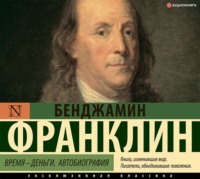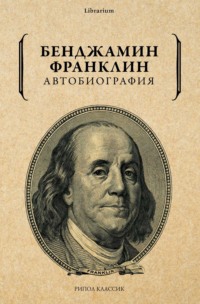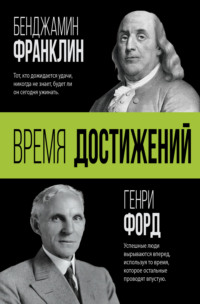 полная версия
полная версияBenjamin Franklin and the First Balloons

Abbott Lawrence Rotch, Benjamin Franklin
Benjamin Franklin and the First Balloons
BENJAMIN FRANKLIN AND THE FIRST BALLOONS
BY ABBOTT LAWRENCE ROTCHThe recent bi-centenary of Franklin’s birth, which coincided with the revival of interest in balloons, makes this a timely topic, especially since Franklin’s descriptions of the first balloon ascensions are almost unknown and do not appear among his philosophical papers. The five letters which I have the honor to present were written to Sir Joseph Banks, President of the Royal Society of London, in 1783, when Franklin was Minister to the Court of France and, with the collateral documents, they give perhaps the most complete and accurate account of the beginning of aerial navigation, enlivened with the humor and speculation characteristic of the writer. It is certainly remarkable that Franklin, in the midst of diplomatic and social duties, could have found time to investigate personally this new invention of which he at once appreciated the possibilities.
The documents which I publish are copies of Franklin’s letters, made on thin paper in a copying press (probably the rotary machine invented by Franklin), and all but one bear his signature in ink. They have corrections in the author’s hand-writing and, except for a few words, are quite legible. They were purchased by me from Dodd, Mead & Co., in December, 1905, and previously had belonged to G. M. Williamson, of Grandview-on-the-Hudson, to whom they had come from Vienna. None of the letters appear in Sparks’ edition of Franklin’s Works, and while all but one are included in the collections compiled by Bigelow and Smyth, there are numerous inaccuracies, some of which will be specified hereafter. Drafts of three of the letters are deposited in the University of Pennsylvania, but the existence of one letter and the whereabouts of another were unknown to the late Mr. Smyth, the editor of the last and most complete edition of Franklin’s Works,1 who made careful search for the original documents. Although the American owners of these copies did not allow them to be transcribed, Mr. Smyth states that he printed one letter from my copy, and he noted how the other copies differed from the drafts in the University of Pennsylvania. In general it may be said that, whereas Bigelow gives the text without paragraphs, capital letters or the old spelling,2 Smyth follows the originals more closely. In view of the historic and scientific interest of these letters, they are now printed exactly according to the press-copies. The letter dated November 30, appears never to have been printed and whereas Smyth reproduced the letter of November 21 from the University of Pennsylvania draft, this or another draft (or possibly this copy) was in the possession of the French aeronaut, Gaston Tissandier, about 1887.3
(THE FIRST HYDROGEN BALLOON.)
Passy, Aug. 30, 1783.Sir,
On Wednesday, the 27th Instant the new aerostatic Experiment, invented by Messrs. Montgolfier, of Annonay, was repeated by M. Charles, Professor of experimental Philosophy at Paris.
A hollow Globe 12 feet Diameter was formed of what is called in England Oiled Silk, here Taffetas gommé, the Silk being impregnated with a Solution of Gum elastic in Lintseed Oil, as is said. The Parts were sewed together while wet with the Gum, and some of it was afterwards passed over the Seams, to render it as tight as possible.
It was afterwards filled with the inflammable Air that is produced by pouring Oil of Vitriol upon Filings of Iron, when it was found to have a tendency upwards so strong as to be capable of lifting a Weight of 39 Pounds, exclusive of its own Weight which was 25 lbs. and the Weight of the Air contain’d.
It was brought early in the morning to the Champ de Mars, a Field in which Reviews are sometimes made, lying between the Military School and the River. There it was held down by a Cord till 5 in the afternoon, when it was to be let loose. Care was taken before the Hour to replace what Portion had been lost, of the inflammable Air, or of its Force, by injecting more.
It is supposed that not less than 50,000 People were assembled to see the Experiment. The Champ de Mars being surrounded by Multitudes, and vast Numbers on the opposite Side of the River.
At 5 aClock Notice was given to the Spectators by the Firing of two Cannon, that the Cord was about to be cut. And presently the Globe was seen to rise, and that as fast as a Body of 12 feet Diameter, with a force only of 39 Pounds, could be suppos’d to move the resisting Air out of its Way. There was some Wind, but not very strong. A little Rain had wet it, so that it shone, and made an agreeable Appearance. It diminished in Apparent Magnitude as it rose, till it enter’d the Clouds, when it seem’d to me scarce bigger than an Orange, and soon after became invisible, the Clouds concealing it.
The Multitude separated, all well satisfied and delighted with the Success of the Experiment, and amusing one another with discourses of the various uses it may possibly be apply’d to, among which many were very extravagant. But possibly it may pave the Way to some Discoveries in Natural Philosophy of which at present we have no Conception.
A Note secur’d from the Weather had been affix’d to the Globe, signifying the Time & Place of its Departure, and praying those who might happen to find it, to send an account of its State to certain Persons at Paris. No News was heard of it till the next Day, when Information was receiv’d, that it fell a little after 6 aClock, at Gonesse, a Place about 4 Leagues Distance, and that it was rent open, and some say had Ice in it. It is suppos’d to have burst by the Elasticity of the contain’d Air when no longer compress’d by so heavy an Atmosphere.
One of 38 feet Diameter is preparing by Mr. Montgolfier himself, at the Expence of the Academy, which is to go up in a few Days. I am told it is constructed of Linen & Paper, and is to be filled with a different Air, not yet made Public, but cheaper than that produc’d by the Oil of Vitriol, of which 200 Paris Pints were consum’d in filling the other.
It is said that for some Days after its being filled, the Ball was found to lose an eighth Part of its Force of Levity in 24 Hours; Whether this was from Imperfection in the Tightness of the Ball, or a Change in the Nature of the Air, Experiments may easily discover.
I thought it my Duty, Sir, to send an early Account of this extraordinary Fact, to the Society which does me the honour to reckon me among its Members; and I will endeavour to make it more perfect, as I receive farther Information.
With great Respect, I am, Sir,Your most obedient and most humble ServantB. FRANKLINSir Joseph Banks, Bart.
P. S. Since writing the above, I am favour’d with your kind Letter of the 25th. I am much obliged to you for the Care you have taken to forward the Transactions, as well as to the Council for so readily ordering them on Application. Please to accept and present my Thanks.
I just now learn, that some observers say, the Ball was 150 Seconds in rising, from the Cutting of the Cord till hid in the Clouds; that its height was then about 500 Toises, but, being moved out of the Perpendicular by the Wind, it had made a Slant so as to form a Triangle, whose Base on the Earth was about 200 Toises. It is said the Country People who saw it fall were frightned, conceiv’d from its bounding a little, when it touched the Ground, that there was some living Animal in it, and attack’d it with Stones and Knives, so that it was much mangled; but it is now brought to Town and will be repaired.
The great one of M. Montgolfier, is to go up, as is said, from Versailles, in about 8 or 10 Days; It is not a Globe but of a different Form, more convenient for penetrating the Air. It contains 50,000 cubic Feet, and is supposed to have Force of Levity equal to 1500 pounds weight. A Philosopher here, M. Pilatre du Rozier has seriously apply’d to the Academy for leave to go up with it, in order to make some Experiments. He was complimented on his Zeal and Courage for the Promotion of Science, but advis’d to wait till the management of these Balls was made by Experience more certain & safe. They say the filling of it in M. Montgolfier’s Way will not cost more than half a Crown. One is talk’d of to be 110 feet Diameter. Several Gentlemen have ordered small ones to be made for their Amusement. One has ordered four of 15 feet Diameter each; I know not with what Purpose; But such is the present Enthusiasm for promoting and improving this Discovery, that probably we shall soon make considerable Progress in the art of constructing and using the Machines.
Among the Pleasanteries Conversation produces on this Subject, some suppose Flying to be now invented, and that since Men may be supported in the Air, nothing is wanted but some light handy Instruments to give and direct Motion. Some think Progressive Motion on the Earth may be advanc’d by it, and that a Running Footman or a Horse slung and suspended under such a Globe so as to have no more of Weight pressing the Earth with their Feet, than Perhaps 8 or 10 Pounds, might with a fair Wind run in a straight Line across Countries as fast as that Wind, and over Hedges, Ditches & even Waters. It has been even fancied that in time People will keep such Globes anchored in the Air, to which by Pullies they may draw up Game to be preserved in the Cool & Water to be frozen when Ice is wanted. And that to get Money, it will be contrived to give People an extensive View of the Country, by running them up in an Elbow Chair a Mile high for a Guinea &c. &c.
B. F.(A HOT AIR BALLOON CARRYING ANIMALS.)
Passy, Oct. 8, 1783.Sir,
The Publick were promised a printed particular Account of the Rise & Progress of the Balloon Invention, to be published about the End of last month. I waited for it to send it to you, expecting it would be more satisfactory than anything I could write; but it does not appear. We have only at present the enclosed Pamphlet, which does not answer the expectation given us. I send you with it some prints. That of the Balloon raised at Versailles is said to be an exact representation. I was not present, but am told it was filled in about ten minutes by means of burning Straw. Some say water was thrown into the flame, others that it was Spirits of Sal Volatile. It was supposed to have risen about 200 Toises: But did not continue long at that height, was carried horizontally by the Wind, and descended gently as the Air within grew cooler. So vast a Bulk when it began to rise so majestically in the Air struck the spectators with surprise and Admiration. The Basket contained a sheep, a duck, and a Cock, who, except the Cock, received no hurt by the fall.
The Duke de Crillon made a feast last week in the Bois de Boulogne, just by my habitation, on occasion of the Birth of two Spanish Princes; after the Fireworks we had a Balloon of about 5 feet Diameter filled with permanent inflammable Air. It was dismissed about One aClock in the Morning. It carried under it a large Lanthorn with inscriptions on its sides. The Night was quite calm and clear, so that it went right up. The appearance of the light diminished gradually till it appeared no bigger than one of the Stars, and in about twenty minutes I lost sight of it entirely. It fell the next Day on the other side of the same Wood near the Village Boulogne, about half after twelve, having been suspended in the Air eleven hours and a half. It lodged in a tree, and was torn in getting it down; so that it cannot be ascertained whether it burst when above, or not, tho’ that is supposed. Smaller Repetitions of the Experiment are making every day in all quarters. Some of the larger Balloons that have been up are preparing to be sent up again in a few Days; but I do not hear of any material improvements yet made either in the mechanical or Chemical parts of the Operation. Most is expected from the new one undertaken upon subscription by Messieurs Charles and Robert, who are Men of Science and mechanic Dexterity. It is to carry up a Man. I send you enclosed the Proposals, which it is said are already subscribed to by a considerable number and likely to be carried into execution. If I am well at the Time, I purpose to be present, being a subscriber myself, and shall send you an exact Account of Particulars.
With great esteem and respect, for yourself and the Society;I have the honour to be,Sir,Your most obedient& most humble Servant,B. FRANKLINSir Joseph Banks, Bart.
(THE FIRST AERIAL VOYAGE BY MAN.)
Passy, Novr 21st, 1783Dear Sir,
I received your friendly Letter of the 7th Inst. I am glad my Letters respecting the Aerostatic Experiment were not unacceptable. But as more perfect Accounts of the Construction and Management of that Machine have been and will be published before your Transactions, and from which Extracts may be made that will be more particular and therefore more satisfactory, I think it best not to print those Letters. I say this in answer to your Question; for I did not indeed write them with a view of their being inserted. Mr. Faujas de St. Fond acquainted me yesterday that a Book on the Subject which has been long expected, will be publish’d in a few Days, and I shall send you one of them. Enclosed is a Copy of the Procès verbal taken of the Experiment made yesterday in the Garden of the Queen’s Palace la Muette where the Dauphin now resides which being near my House I was present. This Paper was drawn up hastily, and may in some Places appear to you obscure; therefore I shall add a few explanatory Observations.
This Balloon was larger than that which went up from Versailles and carried the Sheep, &c. Its bottom was open, and in the middle of the Opening was fixed a kind of Basket Grate in which Faggots and Sheaves of Straw were burnt. The Air rarified in passing thro’ this Flame rose in the Balloon, swell’d out its sides, and fill’d it.
The Persons who were plac’d in the Gallery made of Wicker, and attached to the Outside near the Bottom, had each of them a Port thro’ which they could pass Sheaves of Straw into the Grate to keep up the Flame, & thereby keep the Balloon full. When it went over our Heads, we could see the Fire which was very considerable. As the Flame slackens, the rarified Air cools and condenses, the Bulk of the Balloon diminishes and it begins to descend. If those in the Gallery see it likely to descend in an improper Place, they can by throwing on more Straw, & renewing the Flame, make it rise again, and the Wind carries it farther.
La Machine poussée par le Vent s’est dirigée sur une des Allées du Jardin. That is against the Trees of one of the Walks. The Gallery hitched among the top Boughs of those Trees which had been cut and were stiff while the Body of the Balloon lean’d beyond and seemed likely to overset. I was then in great Pain for the Men, thinking them in danger of being thrown out, or burnt for I expected that the Balloon being no longer upright the Flame would have laid hold of the inside that leaned over it. But by means of some Cords that were still attach’d to it, it was soon brought upright again, made to descend, & carried back to its place. It was however much damaged.
Planant sur l’Horizon. When they were as high as they chose to be, they made less Flame and suffered the Machine to drive Horizontally with the Wind, of which however they felt very little, as they went with it, and as fast. They say they had a charming View of Paris & its Environs, the Course of the River, &c but that they were once lost, not knowing what Part they were over, till they saw the Dome of the Invalids, which rectified their Ideas. Probably while they were employed in keeping up the Fire, the Machine might turn, and by that means they were desorientés as the French call it.
There was a vast Concourse of Gentry in the Garden, who had great Pleasure in seeing the Adventurers go off so chearfully, & applauded them by clapping &c. but there was at the same time a good deal of Anxiety for their Safety. Multitudes in Paris saw the Balloon passing; but did not know there were Men with it, it being then so high that they could not see them.
Développant du Gaz. That is, in plain English, burning more straw; for tho’ there is a little Mystery made, concerning the kind of Air with which the Balloon is filled, I conceive it to be nothing more than hot Smoke or common Air rarify’d, tho’ in this I may be mistaken.
Aiant encor dans leur Galerie les deux tiers de leur Approvisionement. That is their Provision of Straw; of which they carried up a great Quantity. It was well that in the hurry of so hazardous an Experiment, the Flame did not happen by any accidental Mismanagement to lay hold of this Straw; tho’ each had a Bucket of Water by him, by Way of Precaution.
One of these courageous Philosophers, the Marquis d’Arlandes, did me the honour to call upon me in the Evening after the Experiment, with Mr. Montgolfier the very ingenious Inventor. I was happy to see him safe. He informed me that they lit gently without the least Shock, and the Balloon was very little damaged.
This Method of filling the Balloon with hot Air is cheap and expeditious, and it is supposed may be sufficient for certain purposes, such as elevating an Engineer to take a View of an Enemy’s Army, Works, &c. conveying Intelligence into, or out of a besieged Town, giving Signals to distant Places, or the like.
The other Method of filling a Balloon with permanently elastic inflammable Air, and then closing it is a tedious Operation, and very expensive; Yet we are to have one of that kind sent up in a few Days. It is a Globe of 26 feet diameter. The Gores that compose it are red and white Silk, so that it makes a beautiful appearance. A very handsome triumphal Car will be suspended to it, in which Messrs. Robert, two Brothers, very ingenious Men, who have made it in concert with Mr. Charles propose to go up. There is room in this Car for a little Table to be placed between them, on which they can write and keep their Journal, that is take Notes of every thing they observe, the State of their Thermometer, Barometer, Hygrometer, &c which they will have more Leisure to do than the others, having no fire to take Care of. They say they have a contrivance which will enable them to descend at Pleasure. I know not what it is. But the Expence of this Machine, Filling included, will exceed, it is said, 10,000 Livres.
This Balloon of only 26 feet diameter being filled with Air ten times lighter than common Air, will carry up a greater Weight than the other, which tho’ vastly bigger was filled with an Air that could scarcely be more than twice as light. Thus the great Bulk of one of these Machines, with the short duration of its Power, & the great Expence of filling the other will prevent the Inventions being of so much Use, as some may expect, till Chemistry can invent a cheaper light Air producible with more Expedition.
But the Emulation between the two Parties running high, the Improvement in the Construction and Management of the Balloons has already made a rapid Progress; and one cannot say how far it may go. A few Months since the Idea of Witches riding thro’ the Air upon a Broomstick, and that of Philosophers upon a Bag of Smoke, would have appeared equally impossible and ridiculous.
These Machines must always be subject to be driven by the Winds. Perhaps Mechanic Art may find easy means to give them progressive Motion in a Calm, and to slant them a little in the Wind.
I am sorry this Experiment is totally neglected in England where mechanic Genius is so strong. I wish I could see the same Emulation between the two Nations as I see between the two Parties here. Your Philosophy seems to be too bashful. In this Country we are not so much afraid of being laught at. If we do a foolish thing, we are the first to laugh at it ourselves, and are almost as much pleased with a Bon Mot or a good Chanson, that ridicules well the Disappointment of a Project, as we might have been with its Success. It does not seem to me a good reason to decline prosecuting a new Experiment which apparently increases the Power of Man over Matter, till we can see to what Use that Power may be applied. When we have learnt to manage it, we may hope some time or other to find Uses for it, as Men have done for Magnetism and Electricity of which the first Experiments were mere Matters of Amusement.
This Experience is by no means a trifling one. It may be attended with important Consequences that no one can foresee. We should not suffer Pride to prevent our progress in Science. Beings of a Rank and Nature far superior to ours have not disdained to amuse themselves with making and launching Balloons, otherwise we should never have enjoyed the Light of those glorious objects that rule our Day & Night, nor have had the Pleasure of riding round the Sun ourselves upon the Balloon we now inhabit.
With great and sincere Esteem, I am,Dear Sir,Your most obedt& most humble Servant,B. FRANKLINSir Joseph Banks.
(POSTPONEMENT OF CHARLES’ AND ROBERT’S ASCENSION.)
Passy, Nov. 30, 1783Dear Sir,
I did myself the honour of writing to you the Beginning of last Week, and I sent you by the Courier, M. Faujas’s Book upon the Balloons, which I hope you have receiv’d. I did hope to have given you to day an Account of Mr. Charles’s grand Balloon, which was to have gone up yesterday; but the filling it with inflammable Air having taken more time than had been calculated, it is deferr’d till to-morrow. I send you herewith a Paper in which you will see what was proposed by Messrs Robert who constructed the Machine; and some other Papers relative to the same Subject, the last of which is curious, as containing the Journal of the first Aerial Voyage performed by Man. – I purpose being present to-morrow at the Experiment, and shall give you an Acct of it by the Wednesday’s Post. With sincere & great Esteem, I have the honour to be,
Sir, Your most obedt humble ServtB. FRANKLINSir Jos. Banks, Bart.
(THE SECOND AERIAL VOYAGE BY MAN.)
Passy, Dec. 1, 1783.Dear Sir,
In mine of yesterday, I promis’d to give you an Account of Messrs. Charles & Robert’s Experiment, which was to have been made at this Day, and at which I intended to be present. Being a little indispos’d, & the Air cool, and the Ground damp, I declin’d going into the Garden of the Tuilleries where the Balloon was plac’d, not knowing how long I might be oblig’d to wait there before it was ready to depart; and chose to stay in my Carriage near the Statue of Louis XV. from whence I could well see it rise, & have an extensive View of the Region of Air thro’ which, as the Wind sat, it was likely to pass. The Morning was foggy, but about one aClock, the Air became tolerably clear, to the great Satisfaction of the Spectators, who were infinite, Notice having been given of the intended Experiment several Days before in the Papers, so that all Paris was out, either about the Tuilleries, on the Quays & Bridges, in the Fields, the Streets, at the Windows, or on the Tops of Houses, besides the Inhabitants of all the Towns & Villages of the Environs. Never before was a philosophical Experiment so magnificently attended. Some Guns were fired to give Notice, that the Departure of the great Balloon was near, and a small one was discharg’d which went to an amazing Height, there being but little Wind to make it deviate from its perpendicular Course, and at length the Sight of it was lost. Means were used, I am told, to prevent the great Balloon’s rising so high as might indanger its Bursting. Several Bags of Sand were taken on board before the Cord that held it down was cut, and the whole Weight being then too much to be lifted, such a Quantity was discharg’d as to permit its Rising slowly. Thus it would sooner arrive at that Region where it would be in Equilibrio with the surrounding Air, and by discharging more Sand afterwards, it might go higher if desired. Between One & Two aClock, all Eyes were gratified with seeing it rise majestically from among the Trees, and ascend gradually above the Buildings, a most beautiful Spectacle! When it was about 200 feet high, the brave Adventurers held out and wav’d a little white Pennant, on both Sides their Car, to salute the Spectators, who return’d loud Claps of Applause. The Wind was very little, so that the Object, tho’ moving to the Northward, continued long in View; and it was a great while before the admiring People began to disperse. The Persons embark’d were Mr. Charles, Professor of Experimental Philosophy, & a zealous Promoter of that Science; and one of the Messieurs Robert, the very ingenious Constructors of the Machine. When it arrived at its height, which I suppose might be 3 or 400 Toises, it appeared to have only horizontal Motion. I had a Pocket Glass, with which I follow’d it, till I lost Sight, first of the Men, then of the Car, and when I last saw the Balloon, it appear’d no bigger than a Walnut. I write this at 7 in the Evening. What became of them is not yet known here. I hope they descended by Day-light, so as to see & avoid falling among Trees or on Houses, and that the Experiment was completed without any mischievous Accident which the Novelty of it & the want of Experience might well occasion. I am the more anxious for the Event, because I am not well inform’d of the Means provided for letting themselves gently down, and the Loss of these very ingenious Men would not only be a Discouragement to the Progress of the Art, but be a sensible Loss to Science and Society.







![Memoirs of Benjamin Franklin; Written by Himself. [Vol. 2 of 2]](/covers_200/24858395.jpg)

![Memoirs of Benjamin Franklin; Written by Himself. [Vol. 1 of 2]](/covers_200/24858139.jpg)